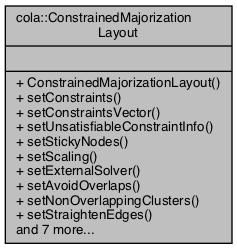Implements the Constrained Majorization graph layout algorithm (deprecated). More...
#include <cola.h>

Public Member Functions | |
| ConstrainedMajorizationLayout (vpsc::Rectangles &rs, std::vector< Edge > const &es, RootCluster *clusterHierarchy, const double idealLength, EdgeLengths eLengths=StandardEdgeLengths, TestConvergence *doneTest=nullptr, PreIteration *preIteration=nullptr, bool useNeighbourStress=false) | |
| Constructs a constrained majorization layout instance. More... | |
| void | setConstraints (cola::CompoundConstraints *ccs) |
| Specify a set of compound constraints to apply to the layout. More... | |
| void | setUnsatisfiableConstraintInfo (UnsatisfiableConstraintInfos *unsatisfiableX, UnsatisfiableConstraintInfos *unsatisfiableY) |
| Register to receive information about unsatisfiable constraints. More... | |
| void | setStickyNodes (const double stickyWeight, std::valarray< double > const &startX, std::valarray< double > const &startY) |
| void | setScaling (bool scaling) |
| void | setExternalSolver (bool externalSolver) |
| void | setAvoidOverlaps (bool horizontal=false) |
| void | setNonOverlappingClusters () |
| void | setStraightenEdges (std::vector< straightener::Edge *> *straightenEdges, double bendWeight=0.01, double potBendWeight=0.1, bool xSkipping=true) |
| void | moveBoundingBoxes () |
| void | run (bool x=true, bool y=true) |
| Implements the main layout loop, taking descent steps until stress is no-longer significantly reduced. More... | |
| void | runOnce (bool x=true, bool y=true) |
| Same as run(), but only applies one iteration. More... | |
Detailed Description
Implements the Constrained Majorization graph layout algorithm (deprecated).
The optimisation method used is "stress majorization", where a sequence of quadratic functions which strictly bound the stress from above, is solved to monotonically reduce the stress (by iteratively changing the configuration of nodes).
Once the problem has been set up, call run() or runOnce() to run the layout algorithm.
- Note
- We recommend the use of ConstrainedFDLayout instead of this class. ConstrainedFDLayout tends to produce better results and has more features. We are no longer working on ConstrainedMajorizationLayout.
Constructor & Destructor Documentation
◆ ConstrainedMajorizationLayout()
| cola::ConstrainedMajorizationLayout::ConstrainedMajorizationLayout | ( | vpsc::Rectangles & | rs, |
| std::vector< Edge > const & | es, | ||
| RootCluster * | clusterHierarchy, | ||
| const double | idealLength, | ||
| EdgeLengths | eLengths = StandardEdgeLengths, |
||
| TestConvergence * | doneTest = nullptr, |
||
| PreIteration * | preIteration = nullptr, |
||
| bool | useNeighbourStress = false |
||
| ) |
Constructs a constrained majorization layout instance.
- Parameters
-
[in] rs Bounding boxes of nodes at their initial positions. [in] es Simple pair edges, giving indices of the start and end nodes in rs. [in] clusterHierarchy A pointer to a RootCluster object defining the cluster hierarchy (optional). [in] idealLength Aa scalar modifier of ideal edge lengths in eLengths. [in] eLengths Individual ideal lengths for edges. The actual ideal length used for the ith edge is idealLength*eLengths[i], or if eLengths is empty then just idealLength is used (i.e., eLengths[i] is assumed to be 1). [in] done A test of convergence operation called at the end of each iteration (optional). [in] preIteration An operation called before each iteration (optional).
Member Function Documentation
◆ moveBoundingBoxes()
|
inline |
Update position of bounding boxes.
◆ run()
| void cola::ConstrainedMajorizationLayout::run | ( | bool | x = true, |
| bool | y = true |
||
| ) |
Implements the main layout loop, taking descent steps until stress is no-longer significantly reduced.
- Parameters
-
[in] x If true, layout will be performed in x-dimension (default: true). [in] y If true, layout will be performed in y-dimension (default: true).
References vpsc::HORIZONTAL, setScaling(), and vpsc::VERTICAL.

◆ runOnce()
| void cola::ConstrainedMajorizationLayout::runOnce | ( | bool | x = true, |
| bool | y = true |
||
| ) |
Same as run(), but only applies one iteration.
This may be useful here it's too hard to implement a call-back (e.g., in java apps).
- Parameters
-
[in] x If true, layout will be performed in x-dimension (default: true). [in] y If true, layout will be performed in y-dimension (default: true).
References vpsc::HORIZONTAL, setScaling(), and vpsc::VERTICAL.

◆ setAvoidOverlaps()
|
inline |
At each iteration of layout, generate constraints to avoid overlaps. If bool horizontal is true, all overlaps will be resolved horizontally, otherwise some overlaps will be left to be resolved vertically where doing so leads to less displacement
◆ setConstraints()
|
inline |
Specify a set of compound constraints to apply to the layout.
- Parameters
-
[in] ccs The compound constraints.
◆ setExternalSolver()
|
inline |
Says that the Mosek optimisation library should be used to solve the quadratic programs rather than the libvpsc solver.
◆ setNonOverlappingClusters()
|
inline |
Add constraints to prevent clusters overlapping.
◆ setScaling()
|
inline |
◆ setStickyNodes()
| void cola::ConstrainedMajorizationLayout::setStickyNodes | ( | const double | stickyWeight, |
| std::valarray< double > const & | startX, | ||
| std::valarray< double > const & | startY | ||
| ) |
Sticky nodes causes nodes to spring back to (startX,startY) when unconstrained.
◆ setStraightenEdges()
|
inline |
For the specified edges (with routings), generate dummy vars and constraints to try and straighten them. bendWeight controls how hard we try to straighten existing bends potBendWeight controls how much we try to keep straight edges straight
◆ setUnsatisfiableConstraintInfo()
|
inline |
Register to receive information about unsatisfiable constraints.
In the case of unsatisifiable constraints, the solver will drop unsatisfiable constraints of lowest priority. Information about these will be written to these lists after each iteration of constrained layout.
param[out] unsatisfiableX A pointer to an UnsatisfiableConstraintInfos object that will be used to record unsatisfiable constraints in the x-dimension. param[out] unsatisfiableY A pointer to an UnsatisfiableConstraintInfos object that will be used to record unsatisfiable constraints in the y-dimension.
The documentation for this class was generated from the following files:
- libcola/cola.h
- libcola/cola.cpp

 1.8.14
1.8.14